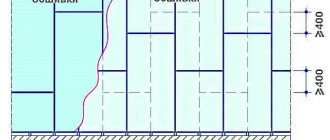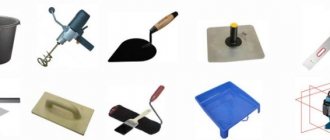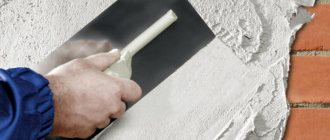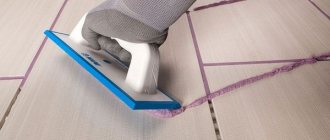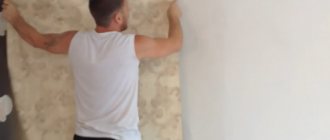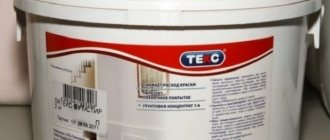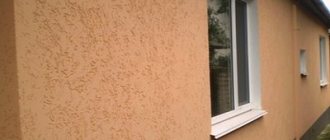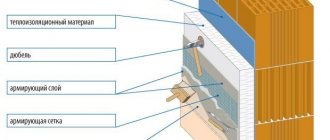Origin of Knauf gypsum plaster
An integral part of repairs and any construction is plastering. The importance of plastering work in any house is difficult to dispute, because the durability and practicality of the entire building as a whole significantly depends on this type of work. This process is very important, since it largely determines how the room will finally look. a huge number of offers on the building materials market . The price segment of these offers is also significant; you can find an option for any budget. However, you need to remember that the stingy pays twice, and cheap raw materials can greatly ruin your nerves both during the work and in the final result.
Wall plaster is designed to protect the walls of a building from the negative effects of the environment. It also ensures compliance with sanitary and hygienic standards in both residential and non-residential premises. It is also worth noting that this material perfectly prepares walls for further wallpapering or laying tiles. You can simply use decorative plastering, which has come back into fashion in recent years.
The choice of material must be approached carefully; the price must correspond to the quality. Quality is tested by time. In our country there is a product that corresponds to the price-quality ratio, this is Knauf plaster . It is produced by a well-known German company. Production facilities are located in Russia, which significantly reduces the cost of this material.
The fact that production is located in our country does not mean that the quality of the material is lower than European. No, the production is state-of-the-art and controlled by German specialists. Products manufactured by Knauf are certified and meet all environmental safety standards. And the quality of the product itself is evidenced by a lot of positive reviews left by experts. In addition, the quality is so high that even an ordinary person without special training can use it in construction at home.
Basic properties of the building mixture
When you go to any hardware store, you can be sure that when asked about choosing a plaster, one of the seller’s first suggestions will be “Knauf”. This building material has won the trust of not only a wide range of consumers, but also entire chains of construction stores.
The main properties of plaster also correspond to this choice:
- High adhesion (high adhesion to various surfaces) of plaster;
- Various mineral additives increase service life;
- The quality of the mixture allows you to avoid defects such as roughness, air bubbles, etc. This property allows beginners to work with this material.
Any building contains premises that require renovation. The range of uses of Knauf is quite wide; it is suitable not only for one type of construction work . Widespread use also explains the high popularity of the product. Where and how you can use it:
- The plaster is suitable for application to many surfaces: concrete, brick, plasterboard, cement mixtures. This versatility allows you to significantly save time when implementing finishing work. This property positively distinguishes it from many other manufacturers who have a narrower application based on the type of surface.
- The material can be used for both roughing and finishing surfaces. The layer that plaster can be applied reaches 50 millimeters, which is a very serious indicator. This property also helps to save time and money during construction, since one material replaces several (there is no need to purchase separately plaster for the rough coating) . This property gave another name to the plaster - start + finish.
- Plaster is excellent for the preparatory layer when wallpapering, laying tiles, and can even replace conventional wall coverings. As noted earlier, paintable plaster today is considered the latest fashion trend in the design world.
Application
Plaster Diamant 260
Can be used for plastering various surfaces - concrete, cement, plasterboard.
Note. Diamat plaster can be applied manually or using a pump.
The sizes of granules in the composition of plaster can vary from 0.8 mm to 3.5 mm, which determines the labeling of the product. The designation K 30 allows us to determine that the Knauf Diamant fur coat contains 2 mm granules. In addition, the size of the fractions will help you find out what this composition can be used for.
Knauf Diamant bark beetle 1.5 mm
Can be used to decorate walls inside the house. The large format of the components - 2 - 3.5 mm - allows the material to be used for plastering the facade of a building.
A composition with large granules has a higher consumption than a fine-grained material. The consumption of plaster with 2 mm components is 2.5 kg / 1 m². At the same time, the consumption of plaster with a fraction of 0.8 mm is 1.8 kg / 1 m².
Note. The price for a bag of fine-grained bark beetle plaster will be higher than for a coarse-grained composition. This is due to the peculiarities of granule filtration.
To optimally select a material for wall decoration, experts always advise paying attention to the type of surface being treated, as well as the thickness of the decorative layer. It is worth noting that after completing the process of applying Diamond bark beetle decorative plaster of this type, you will receive a surface that has an excellent appearance and also has excellent thermal insulation and sound insulation qualities.
When choosing diamond plaster, pay attention to the instructions for use provided by the manufacturer on each bag. The final texture directly depends on the consistency you prepare the solution, as well as on the type of tools for work.
Advice. For cladding the external walls of a house, purchase compounds with a rough finishing structure.
White plaster Diamant Knauf 260
Used with the addition of color. This way you can get the color you want. Application of Knauf Diamant decorative plaster requires a range of preparatory work. To do this, the surface of the walls must be thoroughly cleaned of dirt, dust, traces of old plaster or paint. If there are cracks, chips, unevenness, or any kind of defects on the walls, then they must be repaired and the surface coated with a primer.
Application of decorative plaster Diamant Knauf “bark beetle”
First of all, the composition of the bag is mixed with clean water in the proportions indicated on the packaging. To obtain a homogeneous mixture, use a construction mixer with the required attachment for mixing. Then, the finished mixture must be left for 15 - 20 minutes, and then stirred again. This is done to prevent sediment from forming. In addition, you need to ensure that no foreign components get into the mass.
The prepared solution is applied to previously prepared walls and carefully leveled using a wide spatula. A special smoothing iron will help give the necessary structure.
Because the composition of the plaster contains components of different size fractions: small as a filler, and large in the form of granules. It is the granules that create grooves of different widths and regulate the thickness of the resulting layer, as well as the consumption of material. As a result, we see a pattern on the surface that resembles the result of the work of bark beetles. Thanks to this, the plaster received its second name - bark beetle.
Features of applying decorative plaster Diamant Knauf require compliance with the procedure. For this work, it is worth purchasing a metal spatula, with which you can apply the mixture in a thickness that will be equal to the size of the large fractions. The granules, in turn, push the filler apart and create recognizable grooves. To make these same granules move horizontally, vertically, in a circle or crosswise, use a plastic trowel in your work. Do not apply the material too thickly, as this may lead to the formation of cracks on the surface.
Note. When working with decorative compositions for plastering walls, it is necessary to adhere to safety precautions, using respiratory and skin protection.
Material consumption
When carrying out finishing work, it is necessary to calculate how much plaster will be required. To do this, you need to accurately determine the area of the surface being processed and the quality of this surface (presence of cracks, depressions and other defects). It is worth noting that all walls in the house must be treated. Considering that Knauf does not belong to cheap building materials, it is necessary to approach this issue competently. The manufacturer indicates that a layer 10 mm thick and an area of one square meter will require ten kilograms of Knauf gypsum plaster. Thus, it is enough to simply calculate the required volume of material.
In some cases, it is still worth taking a few extra bags in reserve in case the wall needs to be treated in several layers. This applies to houses of old construction and those houses that have just been erected. If cosmetic repairs in the room are carried out regularly, then it is better not to count on the reserve, given the ideal condition of the walls, which will only need to be slightly edited with a fresh layer of building material for cleanliness and hygiene.
Rotband
The most popular type of Knauf gypsum plaster today is Rotband. It is described as a universal composition, which allows it to be applied to walls and ceilings. Refers to finishing material for interior work. Application thickness on the wall is 5-50 mm, on the ceiling 5-15 mm. Material consumption for a 10 mm layer is 8.5 kg/m2.
The material resists moisture. The permissible temperature for working with the coating is from +5o to +30o. The moisture resistance indicator allows it to be used in the bathroom and kitchen.
An important characteristic of Rotband plaster is its high fire resistance and environmental friendliness of the material. Walls with this coating “breathe”. Rotband plaster can replace putty. The color of the composition is pink, gray or white.
Can retain its properties in sealed packaging for about 6 months. On sale you can find a bag of dry composition for 25, 30 kg and plaster in a paste state for 20 kg. The price of Knau Rotband plaster is not much more than the cost of other types: from 300 to 350 rubles per bag.
Preparatory work before application
Before starting work, you need to make sure that the room temperature corresponds to the manufacturer’s instructions, this is from plus five to plus thirty degrees. Otherwise, the plaster layer may become deformed and the process will need to be repeated.
Before applying plaster, it is necessary to prepare the surface. If necessary, remove old layers, remove dust and dirt. The presence of nails, screws and other metal objects is unacceptable: firstly, the plaster does not adhere to the metal, and secondly, traces of rust are difficult to remove and additional processing . The worst thing is if in the future similar stains from unremoved metal parts begin to appear on fresh repairs. Then the repair will have to be done again.
If the plaster is applied to foam concrete or brick (surfaces with high moisture absorption), it is necessary to additionally treat such surfaces with a primer. Then the building material will not lose its qualities and will last as long as possible, protecting and preserving the walls.
Consumption of Diamant Knauf plaster
Those who are planning to start covering the external walls of a house with plaster probably have a question - how much material will need to be used per 1 m²? Considering the incredible losses, you will need at least 3.8 kg of plaster per square meter. Knauf Diamant “bark beetle” is characterized by having minimal consumption. And taking into account the affordable price of the material, it rightfully occupies a leading position in sales. The products are packaged in durable three-layer paper bags, which should preferably be stored in a dry place. After the expiration date, the plaster is not used, as its properties are lost. The average shelf life is about six months.
Share the post “Knauf Diamant - decorative plaster: Features of the composition and methods of application - Review + Video” by copying the link: https://kaksdelatsvoimirukami.ru/knauf-diamant-dekorativnaya-shtukaturka-osobennosti-sostava-i-sposoby-naneseniya-obzor- video/
Preparation of the solution
The most important stage of work is the correct preparation of the solution. This must be done in accordance with the instructions on the package. Experts recommend that you familiarize yourself with it before starting construction work and stock up on all the necessary items.
To prepare the solution you will need:
- Spacious and convenient container;
- Water for mixing;
- Construction mixer.
You will need about half a liter of water per kilogram of dry mixture. Next, using a mixer, stir the solution until smooth and leave for five minutes , after which we stir again. That's it, the solution is ready for application.
It is important to remember that the solution is usable within half an hour, so its amount must be calculated based on the speed of application to the surface. Haste can lead to losses of expensive building material.
Knauf HP Start
The Knauf company also produces HP Start starting plaster. It is designed for initial leveling of the surface manually before further processing and allows you to eliminate defects in walls and ceilings with an amplitude of up to 15 mm. A version of this mixture is available for machine application. It's called MP 75.
Main properties of HP Start starting plaster:
- application layer thickness - 10-30 mm;
- mixture consumption - 10 kg per m2;
- Drying time is about 7 days.
The company also produces primers for gypsum-based plasters. They are compatible with all machine- and hand-applied plaster mixtures.
Advice! Do not apply the mixture in several layers, one on top of the other. The adhesion between the layers is quite weak, which can lead to partial crumbling of the plaster after drying.
Application of construction mixture
The solution is applied to the surface in one layer up to 50 millimeters thick, using movements from bottom to top, if we are talking about a vertical surface. If the plaster is applied to the ceiling, then the movements are performed towards you. If a thick layer of plaster is applied, reinforcement may be necessary, since the solution is quite heavy. Galvanized metal mesh is used for reinforcement.
After about forty minutes the solution will set. Now it is possible to remove, if necessary, excess, this is done with a wide spatula. After the surface has completely dried, you can begin finishing. The plaster is moistened with water, and after the surface has become matte, grouting is done with a sponge trowel.
To give the surface perfect evenness, after complete drying, you can re-apply water and level it with a spatula. This procedure is recommended to be done one day after application.
Application method
Machine application
Machine application - material consumption is minimized, the speed of work is much greater. The layer thickness is in the range of 1-2 cm. The composition for machine application is not recommended for use for manual work. The plaster on the wall surface begins to spread.
Knauf MP 75 plaster is applied by machine. It is characterized by a smooth surface and resistance to high humidity. This type is applied to old coatings, wood surfaces, and drywall.
The permissible layer of material on the wall is 5-50 mm, on the ceiling 5-15 mm. The rate of plaster consumption on a 10 mm layer should not exceed 10 kg/m2. On sale is a 30 kg bag.
Manual application
Hand Application – Most types are applied by hand.
Complete drying process
Knauf does not require any special drying technologies. It is important to ensure that there are no drafts or sudden temperature changes in the room where the work was carried out. It is unacceptable for direct sunlight to hit the plaster . It is not recommended to speed up the process, as this may harm the material. After 24 hours of drying, it is necessary to ventilate the room to remove moisture.
It is important to remember that it may take a week to two for the plaster to dry completely. This period depends on a number of reasons, in particular, the humidity of the room and the material of the walls. Only after the plaster has completely dried can you proceed to the next stage of finishing. “Knauf” can be coated with almost any paint, and tiles can also be laid on top of it.
It is strictly forbidden to use lime mortars , as they damage the plaster due to poor interaction with its ingredients. If the entire process of plastering walls is carried out according to the rules and following the manufacturer’s recommendations, then the durability of Knauf will delight you.


